volume 1 1931-1932
| série: | Tarzan Sunday Pages |
| dessinateur / scénariste: | Foster Harold |
| éditeur: | Flying Buttress EO 1993 |
| genre: | Aventure |
| classement: | biblio1 |
| date: | 1993 |
| format: | cartonné avec jaquette |
| état: | TBE |
| valeur: | 30 € |
| critère: | * |
| remarques: | first volume edited by NBM/Flying Buttress, 2nd printing (NBM being America's first publisher of graphic novels since 1976, located at New York with imprints such as Flying Buttress Classics Library, Amerotica, Eurotica and ComicsLit) under the supervision of Bill Blackbeard out of a sery of 18 volumes, all being accurate reproduction of the Sunday Pages in their full colour and in full size, each volume has about 52 pages, n.b. the sources of these Sunday pages are mainly from the Los Angeles Times and from the Milwaukee Journal edited by UFS (United Features Syndicate) >> comics syndicates >> see information volume 1 1931-1932 with dust jacket from 27.9.1931 (29) to 18.9.1932 (80) = 52 pages drawn by Hal Foster based on the novel of Edgar Rice Burroughs n.b. the pages 1 to 28 were drawn by Rex Maxon (not published in this edition) the complete reprint is finally here, Foster gets Tarzan off to a flying start with French legionnaires in a fight against Arab tribesman, later he is rescued by beautiful Hulvia the High Priestess, a feat he returns twice in kind for the sultry Lenida the Lion-Tamer Bill Blackbeard's introduction covers the first 6 months of Sundays done by Rex Maxon, the volume includes following episodes (number of pages): - hawk of the Desert: 13 - Tarzan's First Christmas: 1 - Tarzan and the Fox: 1 - the Dance of Victory: 1 - aboard a Slave Ship - the Baby of the Apes - the Black Pit - Hulvia the Beautiful: 11 - Lenida the Lion Tamer: 7 - the Return of Korak: 8 - the Elephants' Graveyard: 7 - into the Primeval Swamp part 1: 3 n.b. some pages were illustrated in black and white by Hal Foster from 7.1.1929 to 16.3.1929 stating the origin of Tarzan under the title "Tarzan of the Apes), one of these pages is presented at the beginning of this album giving information and presenting Tarzan's new adventures, from 16.8.1931 each weekly episode appeared with a title on each page 1/ introduction by Bill Blackbeard - 27.9.1931 Harald Foster takes over after the deception caused by previous Tarzan's illustrator Rex Maxon who made of Tarzan rather a kiddy character, instead that of a lord of the jungle - the first 28 pages made by Rex Maxon appeared in the Sunday pages from 15.3.1931 to 20.5.1931 and are not reprinted in this volume 1, except the first page that appeared on 15.3.1931 (see enclosure) as an example of the design work of Maxon (Tarzan and the twins) - description of the unfortunate pages of Rex Maxon which start with Tarzan rescuing in the jungle two foundlings being Bob and Mary and continuing in a rather childish development, whereas the first Foster's page on 27.9.1931 constituted the effective introduction of an adult adventure feature >> strong critic by Blackbeard to Rex Maxon but also to Frank Hoban (illustrator of the covers of three Blue Book magazines 1928-1930) - the idea of bringing Tarzan into comic strips was put by Joe H. Neebe who was like Foster an advertising agency executive - J. Allen-St.John (another illustrator of Tarzan's cover books 1920) was the most famous artist to paint Tarzan after Foster and Hogarth - the first cover book was done by Clinton Pettee in October 1912 for ERB (Edgar Rice Burroughs) 2/ the story following the script of Rex Maxon, Tarzan is saved by his old friend: captain D'Arnot arriving with an aeroplane, follows the story of D'Arnot about his engagement in the French foreign legion; Tarzan and D'Arnot deliver food to a beleaguered French Fort in the desert, Tarzan is taken prisoner with D'Arnot and lieutenant Carnot by the sheikh Abd-el-Krim, chief of desert-trained tribesmen, then delivered by a dancing girl who is shot dead during their flight, afterwards Tarzan is shown celebrating his first Christmas in England, then he rejoined his beloved jungle, big fire in the jungle, problem with the moorish slavers, then Tarzan meet the pigmy tribe and their blonde priestess Hulvia, the story of the white woman Hulvia who has become unwillingly priestess of the black warriors, Tarzan would promise to find a hero-mate for Hulvia and Tarzan finds the young explorer Tom Barry afterwards Tarzan makes the acquaintance of a mysterious woman with the black mask who turns out to be the famous lion-tamer Lenida, the story of Lenida who during a representation was badly mutilated in the face by a lion, she is now willing to take from Hulvia the role of priestess of the black warriors - later on Tarzan meets his son Korak nicknamed the killer (first and last mention of Korak as son of Tarzan), fight against Bolgani the giant-gorilla and afterwards against a pack of other gorillas, Korak is badly wounded and Tarzan is in great danger but both are saved by Tarzan's friends: Tantor the elephant and the Waziri spearmen coming to their rescue >> page 31.7. Korak the white bwana is taken care of by the Waziri and disappears of the adventures of Tarzan meanwhile, Tarzan meets again his little monkey Nkima and receives from Muviro, chief of the Waziri a mysterious message written in blood on a torn piece of shirt, it said: "help at the elephants' graveyard signed by Erich" Erich von Harben, an explorer, is a good friend of Tarzan who decides immediately to go to his help, during his travel Tarzan is injured by a stone and is himself rescued by some great apes of Tarzan's tribe, then Tarzan arrives at the elephants' graveyard where he finds von Harben badly injured and confronted with prehistoric monsters, the two have to retreat and return to gather strength but Tarzan will return to the graveyard, meanwhile flinging off the last remnant of civilization, Tarzan rejoined one of the leaping horde of the apes in the mad dance of the dum-dum in the light of the moon >> pages 18-10, 25-10, 1-11, 17-7 Tarzan make full use of rifle and gun and even of a machine gun >> page 20-12-1931 the message of Tarzan (well written) >> page 10-1-1932 tigers in Africa? >> page 17-7-1932 the hand of Tarzan >> page 28-8-1932 Tarzan's great fear (last panel) >> this volume is made of several short stories (the foreign legion with reference to the French Colonial Empire, the moorish slavers, Hulvia the blonde priestess, Lenida the lion-tamer, Korak son of Tarzan and part one of a long-featured story in the dinosaurs' lost world being the elephants' graveyard; the scenarios are not yet fully developed as is the design, but the whole is in constant improvement, gaining more accuracy and distinction page after page, the graphic is especially improving from page 17-7-1932 on; but in general quite an acceptable volume with quite a good colour n.b 1/ Tarzan is still wearing a hair-band which will be dropped during the episode of the elephants' graveyard (starting 31-7-1932), we can say that these first pages (until the elephants' yard) was a trial period for Foster where he made the hand n.b./2 n.b. Uzuri seems to be Tarzan's estate see page 38 (12-6) in which Tarzan is heading through vast jungle spaces toward his estate (from Cameroon to East Africa being Uzuri) P.S. for more information about Tarzan, Burroughs, Foster and Hogarth >> see file No. 463C (Etude) note: this American edition was taken over by Editions Soleil in French but of very inferior graphic quality and often with mistreated coloring Enclosures - front and back cover of the album - first page of Hal Foster after the one of Maxon - detailed panel with the hand of Tarzan - first page of Maxon for the Sunday in 1931 INFORMATION competition between United Features Syndicate and King Features Syndicate United Feature Syndicate, Inc. (UFS) is a large American editorial column and comic strip newspaper syndication service based in the United States and established in 1919. Originally part of E. W. Scripps Company, it was part of United Media (along with the Newspaper Enterprise Association) from 1978 to 2011, and is now a division of Andrews McMeel Syndication. United Features has syndicated many notable comic strips, including Peanuts, Garfield, Li'l Abner, Dilbert, Nancy, and Marmaduke. United Feature Syndicate was formed in 1919, from 1922 to 1958, United Features was the column, feature (and comics) division of Scripps' United Press Association. Authors syndicated by United Features in its early years included Frank A. Vanderlip, Octavus Roy Cohen, David Lloyd George, Vicente Blasco Ibáñez, Herbert Hoover, Sinclair Lewis, Benito Mussolini, Édouard Herriot and Heywood Broun. It became a dominant player in the syndication market in the early 1930s. In March 1930, United Features acquired the Metropolitan Newspaper Service (ostensibly from the Bell Syndicate) and in late February 1931, Scripps acquired the New York World, which controlled the syndication arms of the Pulitzer company: World Feature Service and Press Publishing Co. (which unlike other syndicates were owned by the paper rather than being separate entities). The Metropolitan Newspaper Service acquisition brought over the comic strips Tarzan and Ella Cinders. The World Feature Service acquisition brought over the comic strips Captain and the Kids, Everyday Movies, Fritzi Ritz, Hawkshaw the Detective, Joe Jinks and Little Mary Mixup. From this point, United Features became a successful distributor of newspaper comics, for the first time distributing color Sunday strips. An April 1933 article in Fortune described United Features as one of the "Big Four" American syndicates (along with King Features Syndicate, Chicago Tribune Syndicate, and the Bell Syndicate) King Features Syndicate, Inc. is an American content distribution and animation studio, consumer product licensing and print syndication company owned by Hearst Communications that distributes about 150 comic strips, newspaper columns, editorial cartoons, puzzles and games to nearly 5,000 newspapers worldwide. King Features Syndicate also produces intellectual properties, develops new content and franchises, like The Cuphead Show! which it produced with Netflix, and licenses its classic characters and properties. King Features Syndicate is a unit of Hearst Holdings, Inc. which combines the Hearst Corporation's cable-network partnerships, television programming and distribution activities and syndication companies. King Features' affiliate syndicates are North America Syndicate and Cowles Syndicate. William Randolph Hearst's newspapers began syndicating material in 1895 after receiving requests from other newspapers. The first official Hearst syndicate was called Newspaper Feature Service, Inc., established in 1913 In 1914, Hearst and his manager Moses Koenigsberg consolidated all of Hearst's syndication enterprises under one banner (although Newspaper Feature Service was still in operation into at least the 1930s). Koenigsberg gave it his own name (the German word König means king) when he launched King Features Syndicate on November 16, 1915. Production escalated in 1916 with King Features buying and selling its own staff-created feature material. A trade publication - Circulation - was published by King Features between 1916 and 1933. In January 1929, the world-famous Popeye the sailor man character was introduced in King Features' Thimble Theater comic strip. King Features had a series of hits during the 1930s with the launch of Blondie (1930–present), Flash Gordon (1934–2003), Mandrake the Magician (1934–2013), and The Phantom (1936–present). In March 1936, a fictional, magical animal called Eugene the Jeep was added to Popeye, and trademarked |
| couvertures: | 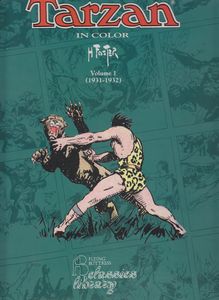 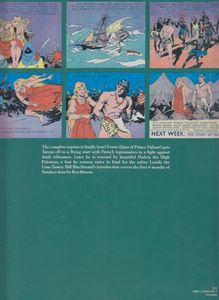 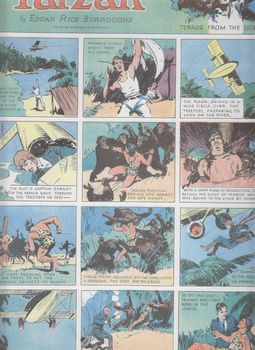 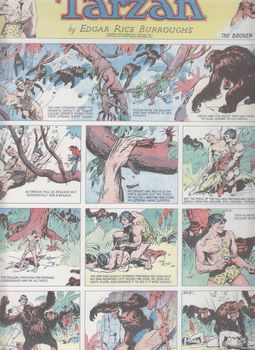 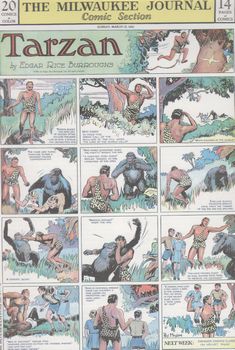 |
Copyright 2008 - 2025 G. Rudolf
